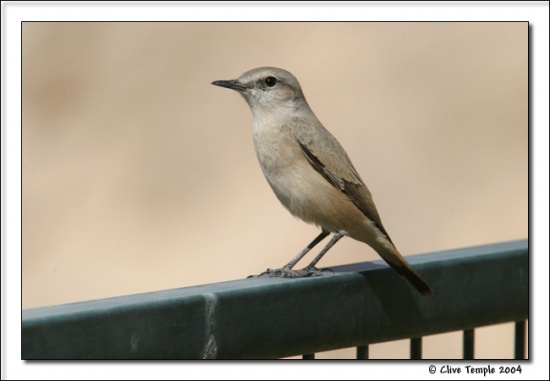m (remove stub) |
m (→Behaviour) |
||
| (13 intermediate revisions by 7 users not shown) | |||
| Line 1: | Line 1: | ||
| − | + | {{incomplete}} | |
| − | + | [[Image:Rufous-tailed_or_Kurdish_Wheatear.jpg|thumb|550px|right|Photo by Gashead.<br />Photo taken: Jebel Hafeet, [[United Arab Emirates]]]] | |
| − | [[Image:Rufous-tailed_or_Kurdish_Wheatear.jpg|thumb|550px|right|Photo by Gashead.<br />Photo taken: Jebel Hafeet, | + | '''Alternative name: Persian Wheatear''' |
| + | ;[[:Category:Oenanthe|Oenanthe]] chrysopygia | ||
==Identification== | ==Identification== | ||
| + | Nondescript grey-brown with rufous tail sides and pale underwing coverts. | ||
==Distribution== | ==Distribution== | ||
| + | Breeds from Transcaucasia to [[Afghanistan]], winters to [[Pakistan]] to northwest [[India]]. | ||
| + | |||
==Taxonomy== | ==Taxonomy== | ||
| − | + | This is a [[Dictionary_M-O#M|monotypic]] species.<br /> | |
| + | It has in the past been considered conspecific with [[Kurdistan Wheatear]]. | ||
| + | |||
==Habitat== | ==Habitat== | ||
| + | It inhabits semi-arid to arid localities including boulder-strewn hillsides and slopes, rocky outcrops, and sandy plains with sparse vegetation cover. | ||
| + | |||
==Behaviour== | ==Behaviour== | ||
| + | Red-tailed Wheatear doesn’t differ much in habits from other wheatears. It is usually seen singly, perching upright on mounds, rock fragments, or on low, thorny bushes. Like other chats and wheatears, it is seen moving swiftly on ground, or among the boulders, mostly for insects. It does perch on low bushes and trees, sometimes catches insects on the wing and returns to the same perch. | ||
| + | |||
| + | ==References== | ||
| + | # Birdforum [http://www.birdforum.net/showthread.php?p=1310387 thread] discussing this species and the possible split. | ||
| + | # Clements, James F. 2007. ''The Clements Checklist of Birds of the World''. 6th ed., with updates to October 2007. Ithaca: Cornell University Press. ISBN 9780801445019 | ||
==External Links== | ==External Links== | ||
| − | {{GSearch|Oenanthe+ | + | {{GSearch|Oenanthe+chrysopygia}} |
| − | [[Category:Birds]] | + | [[Category:Birds]][[Category:Oenanthe]] |
Latest revision as of 11:15, 16 December 2021
| This article is incomplete. This article is missing one or more sections. You can help the BirdForum Opus by expanding it. |
Alternative name: Persian Wheatear
- Oenanthe chrysopygia
Identification
Nondescript grey-brown with rufous tail sides and pale underwing coverts.
Distribution
Breeds from Transcaucasia to Afghanistan, winters to Pakistan to northwest India.
Taxonomy
This is a monotypic species.
It has in the past been considered conspecific with Kurdistan Wheatear.
Habitat
It inhabits semi-arid to arid localities including boulder-strewn hillsides and slopes, rocky outcrops, and sandy plains with sparse vegetation cover.
Behaviour
Red-tailed Wheatear doesn’t differ much in habits from other wheatears. It is usually seen singly, perching upright on mounds, rock fragments, or on low, thorny bushes. Like other chats and wheatears, it is seen moving swiftly on ground, or among the boulders, mostly for insects. It does perch on low bushes and trees, sometimes catches insects on the wing and returns to the same perch.
References
- Birdforum thread discussing this species and the possible split.
- Clements, James F. 2007. The Clements Checklist of Birds of the World. 6th ed., with updates to October 2007. Ithaca: Cornell University Press. ISBN 9780801445019




